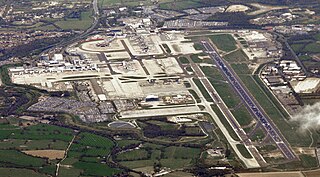
Heathrow Airport, called London Airport until 1966 and now known as London Heathrow, is the main international airport serving London, the capital of England and the United Kingdom. It is the largest of the six international airports in the London airport system. The airport is owned and operated by Heathrow Airport Holdings, owned mostly by Ferrovial and Qatar Investment Authority and CDPQ. In 2022, it was the second-busiest airport in the world by international passenger traffic and the busiest airport in Europe in 2023. It is also the airport with the world's most international connections as of 2023.

London Stansted Airport is the tertiary international airport serving London, England. It is located near Stansted Mountfitchet, Essex, 42 mi (68 km) northeast of Central London.

London Gatwick, also known as Gatwick Airport, is the secondary international airport serving London, England, United Kingdom. It is located near Crawley, West Sussex, England 29.5 miles (47.5 km) south of Central London. In 2022, Gatwick was the second-busiest airport by total passenger traffic in the UK, after Heathrow Airport, and was the 8th-busiest in Europe by total passenger traffic. It covers a total area of 674 hectares.
Heathrow Airport Holdings is the United Kingdom-based operator of Heathrow Airport. The company also operated Gatwick Airport, Stansted Airport, Edinburgh Airport and several other UK airports, but was forced by the Competition Commission to sell them in order to break up a monopoly. It was formed by the privatisation of the British Airports Authority as BAA plc as part of Margaret Thatcher's moves to privatise government-owned assets, and was once a constituent of the FTSE 100 Index.

London has an extensive and developed transport network which includes both public and private services. Journeys made by public transport systems account for 37% of London's journeys while private services accounted for 36% of journeys, walking 24% and cycling 2%,according to numbers from 2017. London's public transport network serves as the central hub for the United Kingdom in rail, air and road transport.
Sir Colin Douglas Buchanan CBE was a Scottish town planner. He became Britain's most famous transport planner following the publication of Traffic in Towns in 1963, which presented a comprehensive view of the issues surrounding the growth of personal car ownership and urban traffic in the UK.
The expansion of Heathrow Airport is a series of proposals to add to the runways at London's busiest airport beyond its two long runways which are intensively used to serve four terminals and a large cargo operation. The plans are those presented by Heathrow Airport Holdings and an independent proposal by Heathrow Hub with the main object of increasing capacity.
In its early years what is now Heathrow Airport was the Great West Aerodrome, sometimes known as Heathrow Aerodrome.

Heathwick is an informal name for a 2011 proposal to create a high-speed rail link between London's Heathrow and Gatwick airports, in effect to combine them into a single aviation travel hub. Proponents argue this would balance their capacity and so reduce the need to add more runways to Heathrow, or more airports in the south-east of England. In 2018 the similar project HS4Air was proposed.
The Thames Hub is a proposal for a new approach to integrated infrastructure development that combines rail, intermodal freight logistics, aviation, tidal renewable energy and its transmission, flood protection and regional development in the Thames Estuary and connects this infrastructure to a trade and utilities spine that runs the length of the UK. It was developed by architects Foster + Partners, infrastructure consultants Halcrow and economists Volterra and launched by Lord Foster at the Institution of Civil Engineers in London on 2 November 2011.
The metropolitan area of London, England, United Kingdom, is served by six international airports and several smaller airports. Together, these airports constitute the busiest airport system in the world by passenger numbers and the second-busiest by aircraft movements. In 2018, the six airports handled a total of 177,054,819 passengers. The London airports handle over 60% of all the UK's air traffic. The airports serve a total of 14 domestic destinations and 396 international destinations.
The Airports Commission was an independent commission established in September 2012 by the Government of the United Kingdom to consider how the UK could "maintain its status as an international hub for aviation and immediate actions to improve the use of existing runway capacity in the next 5 years". Alongside the proposal to build HS2, the question of how to make best use of and expand airport capacity had become the UK's most significant infrastructure issue over the preceding few years.
Thames Hub Airport was a proposed platform-based hub airport located on the Isle of Grain in the Thames Estuary in Kent, whose development has been led by the architect Lord Foster. The idea for the airport was originally included within the Thames Hub integrated infrastructure vision, and the idea of some kind of airport in the Thames Estuary has been discussed since the 1970s.

Heathrow Hub is an independent proposal to expand capacity at London's Heathrow Airport, put forward by Jock Lowe, a former Concorde pilot, and Mark Bostock, an ex-director at Arup Group.
The expansion of Gatwick Airport has involved several proposals aimed at increasing airport capacity in south east England and relieving congestion at the main hub airport Heathrow.
Since the 1950s, London's primary passenger airport has been at Heathrow, with a second one at Gatwick. London's third airport may refer to:
The Roskill Commission was a UK Government Commission charged with looking into finding a site for a new airport for London. Chaired by High Court judge Eustace Roskill, it sat from 1968 to 1970 and published its report in January 1971.

HS4Air is a proposal for a 140-kilometre (87 mi) high-speed railway line in the United Kingdom, put forward in 2018 by a British engineering consultancy, Expedition Engineering.







